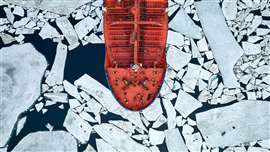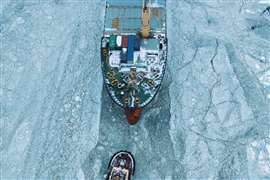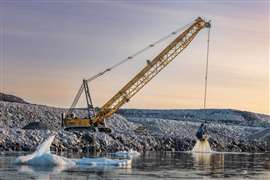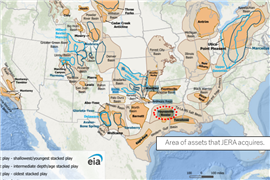IMO committee meeting to address maritime vessel emissions, pollution mitigation in the Arctic
September 25, 2024
 Photo: maxim via Adobe Stock
Photo: maxim via Adobe Stock
The 82nd session of the International Maritime Organization’s (IMO) Marine Environment Protection Committee (MEPC 82) is slated to meet the week of Sept. 30, 2024, at IMO headquarters in London, England. The MEPC meeting is intended to discuss a range of maritime-related environmental protection measures, including those specifically affecting the Arctic. Pollution prevention and mitigation will be on the agenda.
In advance of that meeting, the Clean Arctic Alliance — a consortium of 23 nonprofit agencies with interests in preserving the Arctic — held a webinar to brief interested parties of the environmental issues of most concern with regard to the impact of the maritime industry on the Arctic. It provided insights into what the MEPC will be discussing and how it could affect maritime vessels operating in the region.
Black Carbon Emissions
Bill Hemmings is an advisor to the Clean Arctic Alliance who specializes in black carbon emissions. He said that the MEPC will again consider the regulation of such emissions in the Arctic — the 21st time it has done so since 2011, when at the 62nd MEPC it established a workplan to address the issue.
“Thirteen years later, no concrete reduction measure has been agreed,” Hemmings said. He added, “Ship traffic is expanding rapidly there. Many are large vessels, tankers, bulkers, cargo container ships, service vessels — all burning cheap residual fuel oil [and] emitting large amounts of black carbon, the most potent of short-lived climate forces.”
Hemmings said ships operating in the Arctic can already make significant improvements to black carbon emissions by switching to cleaner marine distillate fuels. He added that these are already used globally and, in some cases, mandated.
In late 2021, the MEPC adopted a resolution — MEPC.342(77) — urging member states and shipping operators to voluntarily switch to distillate fuels, in part to reduce black carbon emissions in the Arctic.
“The climate benefits of reduced black carbon are evident within days,” Hemmings said. “Most of the many smaller fishing vessels in the Arctic already burn cleaner distillate fuel.” He noted that actual emissions of black carbon depend upon engine size, operating conditions, load and maintenance levels.
Hemmings also cited advice from the marine fuel industry provided to the IMO Sub-Committee on Pollution Prevention and Response at its meeting in February (PPR 11) that DMA and DMZ distillate fuels would have a positive impact on reducing black carbon emissions in the Arctic.
“Ruling out future use of residuals in favor of DMA and DMZ polar fuels would in no way restrict the use today of alternative low- or zero-carbon marine fuels, such as blends of biofuels with distillates, power-to-liquid fuels or other fuels, or even at this point, LNG (liquified natural gas),” Hemmings added.
Emission Control Areas
Noting that maritime shipping contributes several emissions that impact the Arctic — black carbon as well as sulfur oxides (SOx), nitrogen oxides (NOx) and fine particulate matter (PM2.5) — Kaare Press-Kristensen, senior advisor for climate and air quality at nonprofit Green Global Future, said two items related to emission control areas (ECA) will be discussed at MEPC 82.
MARPOL, the International Convention for the Prevention of Pollution from Ships, defines an ECA as an area in which certain unique mandatory emissions control measures must be used by ships to mitigate emissions such as SOx, NOx and PM.
Press-Kristensen said one action item would be for the MEPC to formally adopt the designation of the Canadian Arctic and Norwegian Sea as ECAs, per approval of the designation at the last MEPC and which is due to enter into force on March 1, 2026. The other is discussion about designating a North Atlantic ECA.
“If approved, the North Atlantic emission control area will be the largest geographically, closing the gap between the Canadian, the Norwegian, the Northern European and the Mediterranean emission control areas,” he said.
Scrubber Use
Sam Davin, senior specialist in marine conservation and shipping for the World Wildlife Fund (WWF), said the MEPC would be addressing the use of exhaust gas cleaning systems, otherwise known as scrubbers, as part of its discussions on maritime emissions and pollution.
“Scrubbers are used by some operators to meet sulfur emission requirements without switching to cleaner, lower-sulfur fuels,” Davin said. “The result is a new form of marine pollution — so-called scrubber wastewater.”
Davin said that such wastewater is the second largest stream of shipping waste after ballast water, adding that it is toxic to marine life. He called scrubbers a “loophole technology” that allows operators to avoid switching to cleaner fuels.
“Ships using scrubbers in conjunction with heavy fuel oil also emit more particulate matter, black carbon and GHGs (greenhouse gases) than those using distillate fuels,” he said, citing PPR documentation. “Unlike lower sulfur fuels, scrubbers can break, and they can malfunction, making them especially unfit for meeting the strict requirements of emission control areas.”
Davin said there are legal analyses relevant to the discussion of scrubber use, including Regulation 4 of MARPOL Annex VI, which addresses air pollution.
The regulation “provides for states to approve alternative compliance methods,” he said, “but also entails an obligation to endeavor not to damage or impair the environment, human health, property or resources.”
According to Davin, scrubbers do not meet these requirements, and thus do not qualify as alternative compliance methods.
“Scrubbers reduce sulfur emissions but increase particulate matter, black carbon and CO2 (carbon dioxide) emissions,” he said. “When they fail to operate, no sulfur emission reductions are achieved.”
Davin said the WWF and Clean Arctic Alliance hope the MEPC will amend MARPOL Annex VI to address scrubbers and adopt a resolution calling on operators to cease the discharge of scrubber waste in protected areas.
Carbon Intensity Indicator
According to Norwegian risk management firm DNV, the Carbon Intensity Indicator (CII) is a measure of a ship’s energy efficiency. It is measured in grams of CO2 emitted per cargo-carrying capacity and nautical mile.
John Maggs of the Ocean Conservancy and Clean Shipping Coalition said the CII is intended to help drive energy efficiency improvements in shipping.
“Why is this important? Put very simply, it is impossible to meet the IMO’s recently enhanced climate ambitions without the CII driving improved energy efficiency,” he said.
Maggs added that while the shipping industry has significant focus on fuels, they will not come online quickly enough to meet IMO emissions targets.
“Emissions are supposed to drop by 30 percent by 2030 and 80 percent by 2040,” he said. “So, there’s some really heavy lifting going on in the short term. And these reductions are just not possible without emissions reductions as a result of improvements in energy efficiency. And it’s the CII that could drive that.”
Maggs added that CII has the potential to contribute 75 percent of the emissions reductions required by 2030 and about 50 percent of those required by 2040.
“The CII reduces fuel burn, and this is going to help ensure the least cost of decarbonization of shipping,” he said.
The challenge with the CII at the moment, Maggs said, is that it is weak and lacks enforcement.
“The revision process for this starts at MEPC 82 and must conclude before the end of 2026,” he said. He added, “Without a strong revised carbon intensity indicator from 2026, the entire shipping industry will not be able to meet their climate targets. The cost of the shipping industry’s energy transition will be higher than it needs to be.”
MAGAZINE
NEWSLETTER

CONNECT WITH THE TEAM











